Kitchen Decoration Pieces: Enhance Your Culinary Space

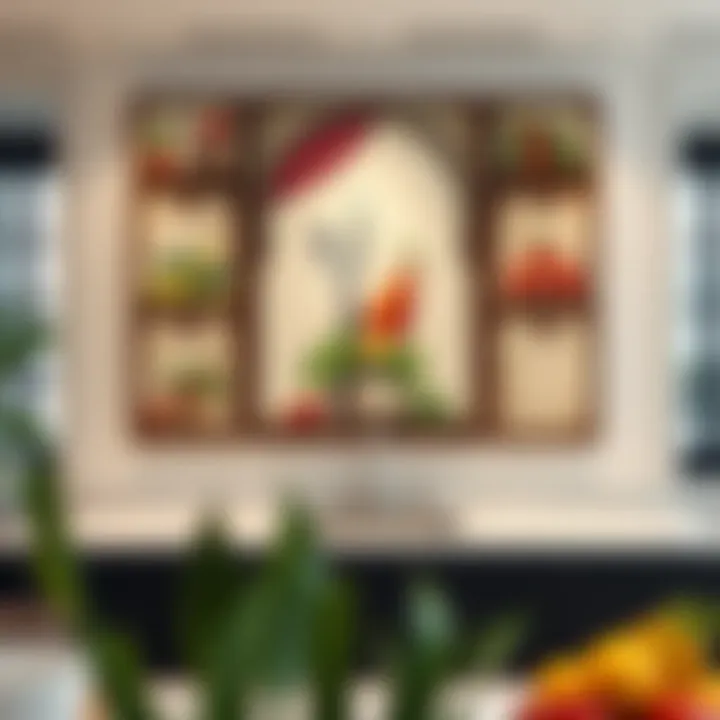
Intro
Every home has a heart, and for many, that heart beats strongly in the kitchen. It’s not just a place to whip up meals; it’s where memories are crafted, friendships are nurtured, and families gather. Therefore, having a well-decorated kitchen goes a long way in creating an inviting atmosphere. In this guide, we will explore various kitchen decoration pieces that can elevate your culinary space, helping you to create something that is uniquely yours.
A harmonious kitchen environment does not simply come about by chance. It requires careful thought regarding the integration of functional and aesthetic elements. Choosing the right decoration pieces can dictate the overall mood and functionality of your kitchen. For homeowners, interior designers, and DIY enthusiasts alike, making informed decisions is paramount to achieving a desired look and feel.
Let’s dive deeper into how to strike that balance between beauty and practicality.
Prologue to Kitchen Decoration Pieces
The kitchen is often described as the heart of the home, a place where culinary delights originate and family bonds strengthen over shared meals. This significance underscores why kitchen decoration pieces are not merely aesthetic; they serve as vital components that enhance both functionality and style. When embarking on the journey of decorating a kitchen, every piece—whether it's a striking piece of wall art or a well-crafted utensil holder—plays a crucial role in shaping the atmosphere.
Importance of Aesthetic and Utility
A carefully curated kitchen decor elevates the space, turning it from a mundane cooking area into a vibrant hub of creativity and daily interactions. The right decor harmonizes with the kitchen's layout, making it feel more inviting and conducive to cooking, entertaining, or simply enjoying a quiet cup of coffee. Take a moment to consider the way textures, colors, and materials can influence the mood. For instance, a rustic wooden shelf can add warmth, while sleek stainless steel appliances can impart a modern flair.
Benefits of Well-Thought-Out Decoration
Engaging with kitchen decoration pieces also brings tangible benefits. From optimizing storage to enhancing light flow, the thoughtful selection of decor serves practical purposes. Here are a few key advantages:
- Stylistic Cohesion: Well-matched decor fosters a unified aesthetic, allowing for a seamless blend of various design elements.
- Functional Enhancements: Decorative pieces can provide additional storage or utilities, merging utility with artistry.
- Increased Resale Value: Homes with appealing and functional kitchen designs tend to attract buyers more readily.
Considerations for Effective Decoration
As one dives into the process of selecting kitchen decorations, several factors deserve consideration:
- Personal Style: Do you lean towards bold, modern designs, or do you prefer classic, timeless pieces? Your preferences should guide the choices.
- Space Constraints: A small kitchen may require clever use of decor that maximizes space without overwhelming it.
- Light and Color: The impact of natural and artificial light in the space must be kept in mind along with the color palette of the decor selections.
Ultimately, focusing on kitchen decoration pieces allows homeowners to create a space that is not only beautiful but also functional. It transforms ordinary kitchens into extraordinary environments, making day-to-day cooking an elevated experience. By understanding these elements, one sets the stage for the subsequent sections that delve deeper into the various aspects of kitchen decor, ensuring informed and thoughtful decision-making.
The Role of Kitchen Decor in Interior Design
Kitchen decoration is not just about aesthetic choices but also about elevating functionality and harmony within one of the most used spaces in any home. A well-decorated kitchen can enhance overall harmony in your home, inviting comfort not only for the home cook but for guests as well. Not to be overlooked, the kitchen decor integrates the culinary space with the rest of the home, making it a critical aspect of interior design.
Decor elements serve multiple purposes, merging creativity with utility. They can affect the mood of the room, shift your perspective on the space itself, and even influence how others perceive your home. By choosing colors, accents, and shapes that reflect your personal style, you can create an environment that resonates with both vibrancy and tranquility. As a result, kitchen decor plays a vital role in shaping the ambiance while fostering a welcoming atmosphere.
Creating Functional Spaces
One of the foremost considerations in kitchen decor revolves around functionality. In particular, the arrangement of decor should support the kitchen’s purpose as a space for cooking and gathering.
- Open shelving: This trend has gained momentum in recent years, allowing for easy access to kitchen essentials while showcasing decorative cookware. It smartly combines practicality with design aesthetics.
- Multifunctional furniture: With limited space in many homes, items like a kitchen island that can serve as both a dining area and a workspace can be game-changers. A bar cart, for instance, can function both as a storage solution and a stylish display.
In addition, consider how the layout of your decor impacts movement and workflow. For example, ensuring that commonly used utensils and seasonings are within arms’ reach can make meal preparation more efficient. A well-planned functional space supports your daily routines while reflecting your unique tastes.
Aesthetic Appeal and Style
Beyond function, there’s the undeniable element of style that kitchen decor can bring to the table. The aesthetic appeal transforms a mundane kitchen into a visual symphony of texture, color, and form. Choosing a cohesive theme or style can elevate the ambiance from generic to remarkable.
Think about:
- Color Schemes: Shading can set the tone. Soft pastels might signal tranquility, while vibrant hues can energize the space.
- Textures: Combining materials such as wood, metal, and ceramics can create a rich sensory experience.
- Artistic Touches: Wall art, decorative plates, or hand-painted tiles can serve as focal points, reflecting personal stories or cultural heritage.
It’s essential to blend these elements to create a space that is not just beautiful but feels like home. When guests walk into a well-decorated kitchen, they experience warmth and character; it becomes an extension of personal identity amidst the bustling environment of meal preparation.
"A kitchen is not just for cooking; it is a canvas where every detail tells a story."
In sum, the role of kitchen decor in interior design is crucial. It intricately weaves function with style, ultimately merging to create a space where culinary art can flourish, and memories can be formed. This harmonious balance serves as the backbone of a kitchen that feels both practical and inviting.
Key Elements of Kitchen Decoration
When it comes to creating a kitchen that’s not just functional but also a feast for the eyes, the key elements of decoration play a pivotal role. These elements are the threads that weave together a cohesive aesthetic, making a kitchen feel complete and lived in. From visual appeal to utility, understanding these components can greatly enhance both the usability and charm of your culinary space.
Wall Art and Decor
Choosing the Right Artwork
Choosing artwork for your kitchen may seem trivial at first, but it profoundly impacts the mood of the space. The right pieces can add warmth, personality, and a touch of sophistication. Opting for something that resonates with your style can pull the whole room together. Popular choices often include food-themed prints or bright canvases that invigorate the space.
The unique advantage of selecting art that reflects culinary themes is its ability to spark conversation among guests and create a welcoming atmosphere. The challenge, however, lies in ensuring that your chosen artwork harmonizes with the other decor elements you have in your kitchen. After all, a clash of styles could be more jarring than conversational!
"Artwork plays an integral role in lifting the visual narrative of your kitchen, turning bare walls into storytelling canvases."
Creating a Gallery Wall
A gallery wall can transform a blank stretch of wall into a vibrant array of art pieces that showcase your personality and taste. This option allows for great versatility, with an opportunity to mix and match various sizes and styles of frames. Such creative settings can break the monotony of kitchen spaces, inviting an artistic flair that is as functional as it is beautiful.
One of the standout features of a gallery wall is its ability to fill empty spaces dynamically. Whether it's clustered neatly or laid out in an eclectic manner, it serves as an eye-catching focal point. However, curation is key; too much chaos can lead to a visual overload, diluting the impact of your chosen pieces.
Functionality of Wall-mounted Fixtures
When it comes to decor, it's crucial to strike a balance between form and function, and this is where wall-mounted fixtures come into play. From hanging pots and pans to decorative shelves, these elements serve both practical and aesthetic functions. They save space while displaying essential items, ensuring that the kitchen feels open and organized.
What sets wall-mounted fixtures apart is their versatility—they can be swapped out or reconfigured as your style evolves. That said, one downside is that they require careful planning to avoid clutter. Hence, a well-thought-out arrangement can make all the difference in maintaining a tidy look while also showcasing your favorite kitchen items.
Lighting Options
Importance of Task Lighting

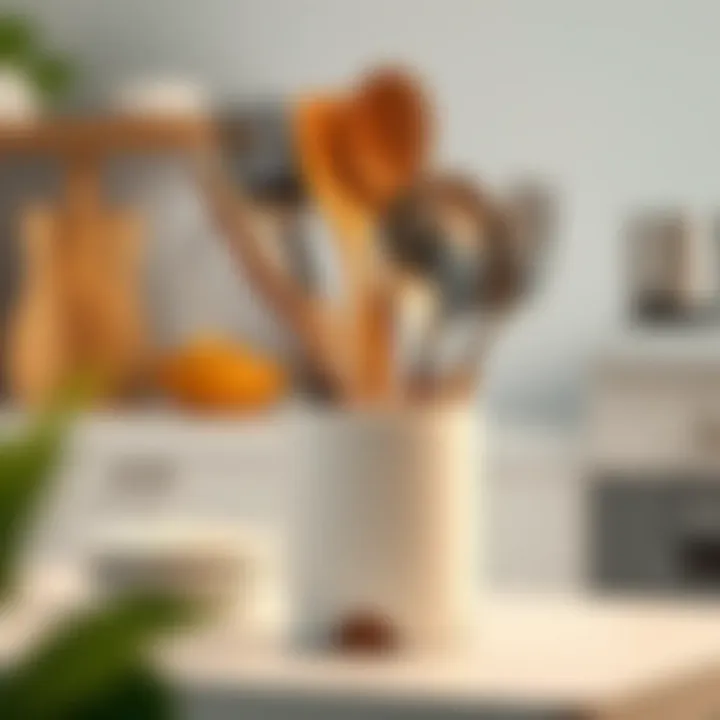
Good task lighting is more than just a practical necessity; it can significantly affect how a kitchen looks and feels. Properly lit work areas enhance safety and efficiency during meal prep, making it a critical element of kitchen design. Crisp, clear light sources over countertops and workspaces highlight colors and textures, drawing out the best in your materials.
Inadequate lighting can create shadows that obscure the beauty of your kitchen design and can become a hazard during cooking. A strong, directed light not only illuminates the space but also contributes positively to the overall kitchen vibe. Thus, investing in effective task lighting is beneficial for operations in the kitchen.
Decorative Fixtures vs. Functionality
The tension between choosing decorative fixtures and ones that emphasize functionality is a familiar plight among decorators. While eye-catching chandeliers and ornamental ceiling lamps can add charm and elegance, they should not overshadow the need for bright, focused lighting in work areas. Striking the right balance requires careful consideration of each fixture’s role.
Mixing different types of fixtures can yield a well-rounded look: perhaps a vibrant pendant light over the dining area paired with practical recessed lights for the prep zones can serve your needs the best. The real test, however, is in how effectively these combinations create a cohesive light scheme.
Trends in Kitchen Lighting
With the evolution of design trends, kitchen lighting has also undergone a transformation. Minimalist designs favor clean lines and fixtures that blend seamlessly into the background, while others trend towards a more industrial or rustic style. Implementing popular trends like under-cabinet lighting or retro pendant lamps can brighten your space while staying current with modern aesthetics.
The unique benefit of incorporating trending designs is the freshness they add to the space. However, it's important to remember that styles can become outdated, which necessitates a careful selection process. Ensuring that your lighting choices not only conform to current trends but also align with your personal style is essential for lasting satisfaction.
Textiles and Soft Furnishings
Selecting Curtains that Complement
When it comes to kitchen textiles, the choice of curtains can completely shift the atmosphere. Opting for light fabrics in cheerful colors can enhance the brightness of the space, while heavier materials may create a cozier feel. Selecting curtains that complement your kitchen decor—whether they are patterned or solid—can tie the look together, making the room feel more organized.
Unique softness from well-chosen textiles can offer warmth and texture to a typically hard-surfaced area. On the downside, curtains can attract grease and grime, necessitating regular maintenance. Keeping this in mind, materials like cotton or synthetic blends that are easier to wash can be favorable selections.
Table Linens as Decorative Elements
Table linens are another splendid way to infuse color and personality into your kitchen. Beyond their practical function of protecting surfaces, well-chosen tablecloths and cloth napkins can elevate meal times. Bold patterns and colors can invigorate an otherwise monotonous table setting, making even a simple breakfast feel more special.
Unique textiles can also add layers of comfort; for instance, using brightly colored placemats alongside neutral tableware creates chic contrast. However, like any textile in the kitchen, table linens may require frequent cleaning to maintain their aesthetic appeal, especially in a high-use area.
Choosing Mats and Rugs for Style and Safety
Rugs and mats can be an essential addition to a kitchen for both style and safety. They can define spaces, provide comfort underfoot, and reduce the risk of slipping, especially in areas prone to spills. Opting for washable materials means they can be maintained with ease, making them practical in a bustling environment.
The unique feature of stylish rugs is their ability to harmonize the room’s color palette while adding warmth. However, one must consider the potential for wear and tear in high-traffic spots. It is critical to select durable options so that they last over time while still providing aesthetic value.
Material Considerations in Kitchen Decor
The materials you choose for kitchen decor can make a world of difference in both appeal and functionality. It's not just about looks; it's about how these elements work within your kitchen's ethos. Good materials can enhance your design, improve longevity, and ensure that your kitchen remains a welcoming space for family and friends. Kitchen decoration is often a blend of style and practicality, where the material you select plays a crucial role in achieving that balance.
Choosing appropriate materials can also enhance your kitchen's overall functionality. For instance, materials such as wood and metal can withstand the wear and tear of daily cooking activities while still elevating the aesthetic of the decor. As trends evolve, understanding the benefits and characteristics of different materials becomes mandatory for anyone looking to update their culinary space. This section digs into wood, metal, ceramics, and glass and how each contributes uniquely to your kitchen’s ambience.
Wood in Decor
Choosing the Right Wood Finishes
Selecting the right wood finishes adds personality and warmth to your kitchen. One prominent characteristic of wood finishes is their variety. From rich, dark stains to light, airy hues, each finish brings its own atmosphere. Popular choices among designers often include walnut for its luxury and oak for its warmth.
These options not only define the style but also offer practical benefits. For example, a natural finish can highlight the wood grain, which might resonate with rustic themes. However, dark stains can evoke sophistication depending on the lighting and surrounding decor.
Unique features to consider include durability and maintenance; some finishes might require more upkeep than others. All in all, choosing the right wood finish contributes significantly to your kitchen's overall aesthetic and functionality.
Natural vs. Painted Options
The debate between natural wood and painted finishes is ongoing, but both have their merits. Natural wood exudes authenticity and warmth, lending itself perfectly to traditional and farmhouse styles. It often boasts unique imperfections, showcasing its organic origins. Conversely, painted options allow for colorful expression, enabling a pop of personality that aligns with contemporary decor.
A key advantage of natural wood is its longevity and timelessness. However, it may not be suitable for every kitchen, especially one that seeks a modern feel. Painted finishes, on the other hand, provide a fresh look but may require more frequent touch-ups to keep them looking their best.
In the end, the choice between natural and painted wood options heavily relies on personal preference and the specific design goals at hand.
Metal Accents
Choosing Metal Finishes
Metal finishes can serve as both a practical and aesthetic choice in kitchen decor. The key here is to know what looks best with the rest of your decorations. Stainless steel remains a classic for its durability and easy maintenance, making it a staple in many kitchen environments. In contrast, brass and copper have gained popularity among modern designs for their distinctive, warm tones that can complement wooden elements beautifully.
The unique feature of metal finishes is the array of textures and sheens available—from brushed to polished. They can enhance the visual intrigue of your culinary space. However, they may also be susceptible to fingerprints and scratches, implying that regular maintenance is necessary to keep them pristine.
Functional and Decorative Metal Pieces
Functional metal pieces, such as pot racks and decorative bowls, integrate style and utility seamlessly. Many homeowners choose these items not just for their usefulness but for how they contribute visually to the kitchen. The easy grace of a well-placed metal piece can turn mundane storage into a focal point.
The key characteristic of combining function and decoration in metal pieces is versatility. They are typically built to withstand heat and humidity, making them ideal for kitchen use. Yet, over time, some pieces might show wear or tarnish, necessitating occasional polish or replacement. In this sense, while metal accents create striking decor, it's wise to choose those that best fit with your lifestyle and care preferences.
Ceramics and Glass
Decorative Serving Pieces
Ceramic and glass pieces offer practical beauty. They can serve multiple purposes—from presenting food to double duty as decor. Their unique quality lies in the wide range of colors, patterns, and styles available.
The distinct advantage of these serving pieces is how they can elevate a meal. Beautifully crafted ceramic dishes may add an artisanal touch, while colorful glassware can catch the light in enchanting ways, transforming an ordinary table setting into an extraordinary one. Yet, they're also prone to breaks and chips, making careful handling essential.
The Role of Glass in Creating Light
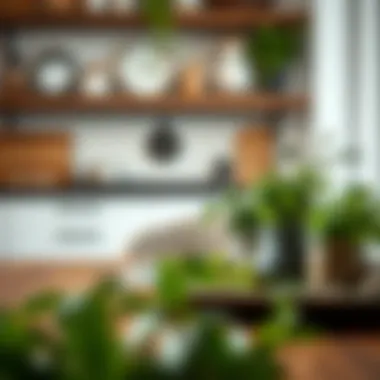
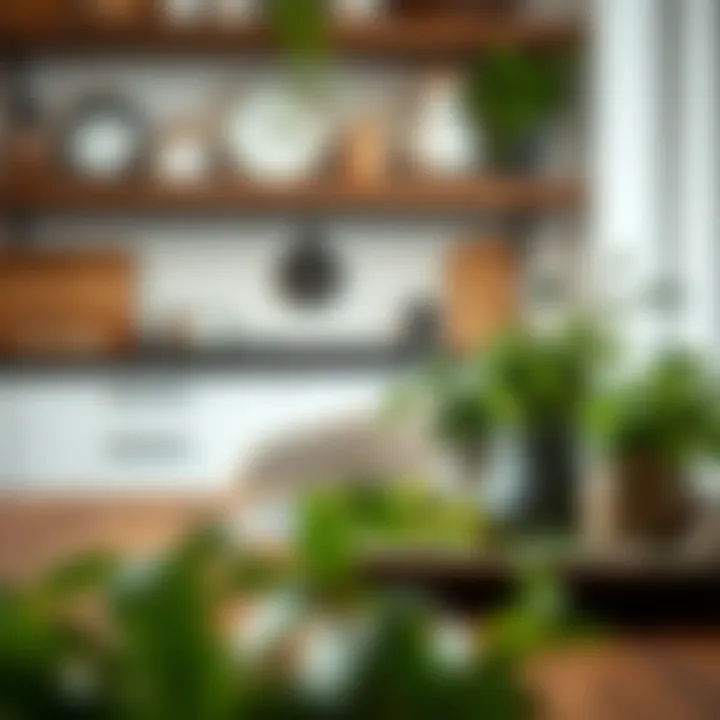
Utilizing glass in kitchen decor can significantly affect brightness and openness in the space. One notable aspect is its ability to reflect light, which can make a small kitchen feel more airy and expansive. Hanging glass pendants or incorporating glass cabinet doors can enhance the illumination, making the space inviting.
A key feature of glass as a material is its flexibility in design—from clear to frosted, it adapts easily to various decor styles. The only caveat is that it can appear cold if not complemented with warmer tones in the kitchen. Balancing glass elements with softer materials can create a welcoming atmosphere.
"The materials in your kitchen not only define its style but also indicate your personal taste and lifestyle preferences."
Ultimately, understanding the characteristics and benefits of various materials is vital for successfully decorating your kitchen. Each type brings its distinct flavor to the table, allowing homeowners to mix and match to create a space reflective of their personality and needs. By considering how materials contribute to functionality and aesthetics, you can transform your kitchen into a space that's not just practical but also a visual retreat.
Functional Decoration: Merging Style with Utility
When it comes to kitchen decor, the harmony between aesthetics and functionality can be a tricky balance to strike. Functional decoration isn't merely about making things look pretty; it emphasizes incorporating essential elements that enhance usage and improve overall experience in the kitchen. In today's fast-paced world, where time and efficiency are of the essence, blending style with utility has become paramount for homeowners and designers alike. This approach ensures that every piece of decor serves a purpose while amplifying the kitchen's appeal.
Storing Essentials Stylishly
Open Shelving Concepts
Open shelving has really taken off in recent years, offering a fresh perspective on kitchen storage. These units invite a sense of airiness and openness, breaking down the claustrophobic feel that cabinets can sometimes create. One standout feature of open shelving is how it turns everyday items—think plates, spices, or cookbooks—into part of the decor. This allows individuals to express their style using items they already own.
However, it's essential to consider the upkeep; dust can accumulate rather quickly, so it requires regular maintenance to ensure everything looks appealing.
- Pros:
- Cons:
- Accessibility: Everything is within arm's reach.
- Style Statement: It allows for creative displays of dishware and decor.
- Maintenance: Requires frequent cleaning to keep things looking their best.
- Limited Space: May not hold as much as traditional cabinets.
Decorative Storage Solutions
When storage issues arise, decorative solutions shine by marrying practicality with design. These can range from chic baskets to bold canisters, adding a personal touch while ensuring that items are organized. The trademark of these pieces is versatility; they can hold anything from utensils to snacks, all while looking fabulous on display.
Using decorative storage allows homeowners to maintain tidiness without sacrificing style. It’s especially beneficial in open concept kitchen spaces where clutter can quickly become an eyesore.
- Highlight of Decorative Storage:
- Unique Contribution: Keeps things organized so your kitchen remains inviting and pleasant to cook in while adding flair to the decor.
Multifunctional Furniture
Another crucial component of functional decoration in the kitchen is multifunctional furniture. With spaces often shrinking, being able to accommodate various functions in single pieces is vital. This can mean everything from folding tables that double as extra countertop space to islands that have built-in storage options.
Convertible Tables and Islands
Convertible tables and islands are a game changer for those who often entertain guests or need multifunctional areas. They can be expanded or retracted according to the occasion. This adaptability makes them popular among those who place high value on efficiency yet don’t want to compromise on style. One unique feature of these tables is that they encourage movement; they can transition from a prep area to a dining table seamlessly, engaging guests in the cooking process.
- Advantages:
- Disadvantages:
- Flexibility: Easily adjust size for different occasions.
- Space Saving: Provides two functions in one piece.
- Can be pricier due to additional designs and mechanics.
- May require more effort for assembly.
Bar Carts and Their Uses
Bar carts are experiencing a resurgence, not just for cocktails but also as mobile storage solutions. They serve as a chic way to organize and present belongings in a kitchen, especially for smaller spaces. Their prominence lies in their mobility and the ability to style them according to taste. Whether hosting a gathering or simply wanting a well-organized area, a bar cart can adapt.
- Fun Fact:
- Not only useful for drinks but can house fruits, cookbooks, or even spices.
Sustainability in Kitchen Decor
Sustainability in kitchen decor is a key topic today, gaining traction among homeowners and designers alike. With the increasing awareness of environmental issues, the kitchen, often referred to as the heart of the home, is an ideal space to reflect one’s values. By making thoughtful choices regarding materials and design, one can create a beautiful culinary space that is also kind to the planet. The benefits of sustainable kitchen decor go beyond aesthetics; they tap into the health of our environment while enhancing our living spaces. Considerations range from the materials used to the lighting choices selected, impacting energy consumption and overall carbon footprint.
Eco-Friendly Materials
Sourcing Sustainable Wood
When looking at sourcing sustainable wood, it’s vital to understand the role this natural resource plays in kitchen decor. Sustainable wood comes from forests that are managed responsibly, ensuring regrowth and minimizing ecological disruption. This not only helps preserve biodiversity, but it also promotes a healthier planet. One key characteristic of sustainable wood is that it is often harvested from trees grown in well managed forests that practice reforestation.
Choosing sustainable wood is beneficial for several reasons. First, it often has a unique aesthetic appeal, providing rich textures and captivating grain patterns that can enhance any kitchen design. Second, sustainable wood comes with the psychological reassurance that you are contributing to environmental efforts. However, the availability and costs of sustainably sourced wood can sometimes pose a challenge. The commitment to using this type of material reflects a dedication to eco-friendliness, but it may require a bit more effort to locate and a slightly higher investment initially.
Using Recycled Materials
On the other hand, using recycled materials is another exciting option in kitchen decor. This involves repurposing items from other projects or products that have reached the end of their life cycle. Simple as it sounds, this practice can significantly reduce waste, minimizing landfill overflow and conserving resources. The standout feature of recycled materials is their versatility — you can find everything from reclaimed wood countertops to vintage metal accents that tell a story and add character to your space.
In addition to its sustainable aspects, incorporating recycled materials often leads to unique designs. Each piece may have its own history, which adds layers of depth to your kitchen’s atmosphere. However, there can be drawbacks, such as consistency in quality and finish. Items made from recycled sources might require more careful consideration during selection to ensure they fit seamlessly within your design framework. Regardless, this approach is increasingly popular among health-conscious and environmentally-aware individuals.
Energy-efficient Lighting
Another crucial aspect of kitchen sustainability is the choice of lighting. Opting for energy-efficient lighting not only conserves electricity but also reduces utility bills over time. LED lights, for example, use significantly less energy than traditional incandescent bulbs and have a longer lifespan. Aside from being a practical choice, they come in a wide range of styles, from sleek and modern to rustic and decorative. Energy-efficient lighting is a straightforward way to merge functionality with environmental mindfulness, making it a sensible choice for those looking to decorate sustainably.
"In the quest for a more sustainable kitchen, every small choice counts. From the materials you select to the type of lighting you use, your decisions make a difference."
Using eco-friendly materials, rediscovering the charm of recycled elements, and investing in energy-efficient lighting can profoundly transform your kitchen. Through these sustainable choices, you invest not only in your space but also in the future of our planet.
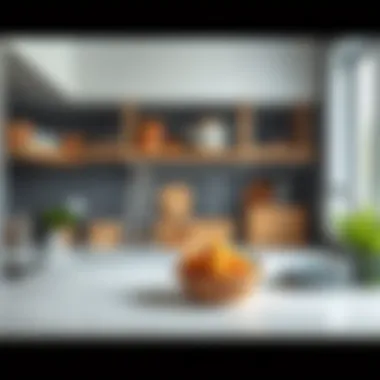

Trends in Kitchen Decoration for Contemporary Homes
The world of kitchen decoration is constantly evolving, reflecting changes in lifestyle, technology, and aesthetic preferences. Understanding current trends in kitchen decoration is essential for creating spaces that are both functional and visually appealing. These trends allow homeowners, interior designers, and decorators to tap into dynamic design elements that enhance not just the beauty of the kitchen, but also its usability.
An important aspect of modern kitchen decoration is the dual focus on functionality and aesthetics. Shifts in consumer behavior suggest that people are looking for spaces that serve multiple purposes, particularly as kitchens increasingly become central hubs for social interaction and family gatherings. This article will delve into two prominent trends that are reshaping kitchen spaces: minimalist approaches and the bold use of colors and patterns.
Minimalist Approaches
Minimalism in kitchen design emphasizes simplicity and clean lines, prioritizing practicality while discarding unnecessary embellishments. This trend isn't just about reducing clutter; it's also a lifestyle choice that reflects a desire for a serene, chaotic-free environment.
Key Features of Minimalist Approaches:
- Sleek Surfaces: Choices like quartz or matte finishes offer understated elegance.
- Neutral Palettes: Shades of white, gray, and black dominate, often complemented by natural wood elements. This creates a cohesive look while allowing culinary creations to take center stage.
- Integrated Appliances: Opting for built-in appliances helps achieve a seamless look, minimizing visual disruption within the kitchen landscape.
Minimalism also champions the idea of intentionality. Every piece of decor and furniture should have a purpose. Open shelving, for instance, can serve as both functional storage and a display for favorite dishes or plants. This not only maintains aesthetic purity but adds personality without overwhelming the space.
Bold Colors and Patterns
On the other end of the spectrum lies the trend of bold colors and patterns. This approach breaks away from the restrained palettes of minimalism, allowing for personal expression and creativity within the kitchen.
Elements of Bold Colors and Patterns:
- Vibrant Color Schemes: Shades like deep navy, emerald green, or rich mustard infuse energy into the kitchen. These colors not only make strong statements but can invigorate the whole atmosphere.
- Textured Tiles and Backsplashes: Geometric patterns or handmade tiles create visual intrigue, serving as eye-catching focal points that draw people into the space.
- Statement Fixtures: Pendant lights in kooky shapes or finishes, like brushed gold or black matte, add character and a dash of drama.
Utilizing colors and patterns can be a fantastic means of reflecting personal style. A lively, patterned wallpaper can make the kitchen feel warm and inviting, while colorful dishware showcased on open shelves can add pops of brightness against a neutral backdrop.
In summary, balancing minimalism with bold expressions allows for spaces that resonate with personal style while still being highly functional. The trends in kitchen decoration for contemporary homes underscore a fluid interplay between beauty and utility, enabling homeowners to tailor their environments to both their aesthetic and practical needs.
Whether you identify with the serene charm of minimalism or the vibrant spirit of bold colors, embracing these trends can lead to kitchen spaces that truly elevate the daily culinary experience.
Personalizing Your Kitchen Space
When it comes to transforming your kitchen into a welcoming and comfortable space, personalization is key. It’s not just about functionality or the latest trends; it’s the unique touches that resonate with you and your family that truly make a kitchen feel like home. Personalizing your kitchen can elevate not only the aesthetic but also create a space that reflects your tastes, traditions, and memories. Here are some thoughtful considerations that can help you create a one-of-a-kind culinary space.
Incorporating Family Heirlooms
One of the most heartfelt ways to personalize your kitchen is by incorporating family heirlooms. Maybe it’s a grandmother’s antique teapot or a set of vintage recipe cards that date back generations. These items carry stories and memories that breathe life into your space.
- Choosing the Right Pieces: Start by combing through your family’s memorabilia. Look for items that hold significance, not just in function but in emotional value. This could be anything from heirloom silverware to old cookbooks.
- Showcase Wisely: Consider displaying these treasures prominently without overwhelming the space. A well-placed cooking pot on a shelf or a framed vintage recipe can be a conversation starter and adds character to your kitchen. Integrate these pieces into your decor while ensuring they maintain their practicality.
- Mixing Old with New: The juxtaposition of heirlooms with modern decor can create an intriguing contrast. For instance, setting an heirloom cutting board against quartz countertops can be visually pleasing.
Family heirlooms enhance your kitchen's charm, bridging past and present with every meal prepared and shared.
Adding Personal Touches
Beyond heirlooms, personal touches can also come through in various ways, adding layers of warmth and individuality to your kitchen.
- Art and Photography: Incorporate framed family photos or local artwork. For a more dynamic display, consider a rotating gallery wall where you can easily swap out images. Nostalgic pictures from family gatherings during holiday feasts can rekindle fond memories every time you pass by.
- Custom Textiles: From curtains to table linens, choose fabrics that match your personality. Bold patterns can provide a modern vibe, while soft pastels can evoke a homey feel. Each piece can serve as an expression of your style, impacting the overall ambiance.
- Scent and Flavor: A personal kitchen is not just about the visuals; consider using herbs and plants that you love. Not only do they beautify the space, but they also fill the air with delightful aromas. Fresh basil or rosemary on the windowsill can connect your culinary activities to nature.
Incorporating personal touches allows you to tailor the kitchen environment to reflect your life and values. From showcasing cherished items to selecting colors and scents that resonate, there's an endless opportunity for creativity.
"Your kitchen is a reflection of who you are; let it tell your unique story."
Adapting these personal elements can result in a space that not only enhances the decor but serves as a backdrop for cherished memories and culinary adventures. Each meal becomes a celebration of life and personal history.
Maintenance and Care for Kitchen Decor
Maintaining and caring for kitchen decor is a critical aspect often overlooked by many homeowners. The kitchen, being one of the most frequently used spaces in the home, experiences wear and tear not only from cooking but also from everyday activities. This section aims to shed light on the importance of upkeep for kitchen decorations, establishing a framework that combines aesthetics with functionality. By ensuring that decor pieces are properly maintained, you can preserve their beauty and extend their life, enhancing the overall ambiance of your culinary environment.
Cleaning and Preservation Tips
Keeping kitchen decor pristine requires a blend of the right cleaning techniques and preventative measures. Regular cleaning is essential to prevent dirt and grime buildup, which can tarnish surfaces and diminish the life of decor pieces. Here are some practical tips:
- Use Gentle Cleaners: Always opt for non-abrasive cleaning solutions tailored to the material of your decor. For instance, a vinegar and water mixture works wonders on glass and ceramic.
- Avoid Harsh Scrubs: Abrasive materials can scratch or dull the finish of delicate items. A soft cloth or sponge is your best friend here.
- Dust Regularly: Dust tends to settle on decor, diminishing its shine. A simple duster or a microfiber cloth can help keep surfaces looking fresh.
- Store Wisely: If you have decorative items that are seasonal or not in use, storing them in a cool, dry place can protect them from unnecessary damage.
Additionally, consider the placement of your decor. Sunlight can fade colors, while humidity can warp materials. Situating items thoughtfully can mitigate these risks.
Routine Care for Fabrics and Textiles
Fabrics and textiles in the kitchen contribute a cozy, inviting feel to the space. However, they also require routine care to maintain their appearance and functionality. Here are guidelines to ensure they last:
- Regular Washing: Table linens, curtains, and cushions should be washed regularly according to their care labels. This helps to remove stains and odors that accumulate over time.
- Protection from Stains: To minimize staining, consider treating textiles with a stain-resistant spray. This is particularly useful for fabrics near food preparation areas.
- Check for Wear and Tear: Regularly examine your fabric items for any signs of wear, such as fraying edges or fading colors. Early detection allows for repairs or replacements before they become unappealing.
- Rotate and Rearrange: If your kitchen textiles are often in sunlight, rotate them periodically to avoid uneven fading. Likewise, rearranging decor periodically can refresh the space, giving it a new vibe without major investments.
"A well-maintained kitchen is a reflection of its owner, showcasing both style and care."
By adopting a culture of care and maintenance, you not only prolong the life of your decor but also elevate the everyday experience of your kitchen. Ultimately, the effort you put into caring for your kitchen decorations will pay off in the form of a welcoming and functional space that reflects your personal taste.
Ending and Final Thoughts
In closing, the exploration of kitchen decoration pieces is a vital aspect to consider for anyone looking to enhance their culinary space. Throughout this comprehensive guide, we have highlighted various elements that can significantly impact both functionality and aesthetics in your kitchen. From the selection of materials to the integration of personal touches, each decision contributes to creating an environment that feels both welcoming and practical.
The benefits of thoughtfully decorated kitchens are manifold. Firstly, a well-decorated kitchen not only serves as a practical area for meal preparation but also stands as a central hub for family gatherings and social interactions. This dual purpose means that every decorative choice, whether it be wall art, lighting options, or textiles, can elevate the experience of cooking and dining.
However, it’s essential to balance beauty with function. For instance, while opting for decorative fixtures, consider their practicality. Task lighting should illuminate work areas efficiently, while decorative items should not clutter but rather enhance the space. By thoughtfully selecting each piece, you keep the kitchen both stylish and functional.
Moreover, embracing sustainable materials in your kitchen decor not only looks good but also reflects a commitment to the environment—something that is increasingly valued by homeowners. The push toward eco-friendly choices provides an opportunity to create a unique space that is in tune with contemporary trends.
Personalization stands out as a cornerstone in kitchen decor. Adding family heirlooms or unique artwork fosters an intimate atmosphere that can make a house feel like a home. This narrative is essential; it transforms a kitchen from merely a culinary workspace into a canvas of cherished memories and personal expression.
Ultimately, as we wrap up this guide, it's clear that there is much to consider in the realm of kitchen decoration. The harmonious integration of style, functionality, and personal touch culminates in a culinary space that is truly inviting and reflective of one's personality. Therefore, as you embark on your kitchen decorating journey, remember that each piece, no matter how small, plays its role in shaping the heart of your home.















